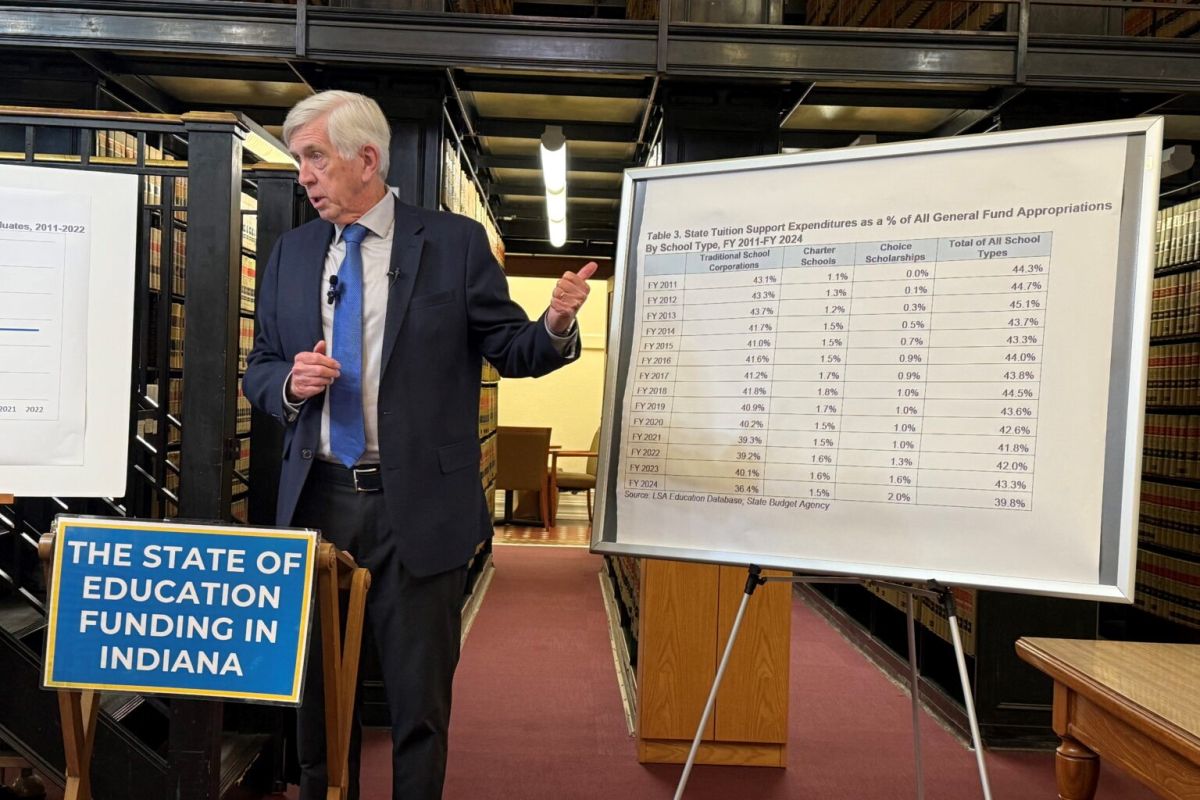
Rep. Ed DeLaney, D-Indianapolis, discusses a new legislative fiscal analysis on Indiana school funding during a news briefing on Wednesday, Oct. 2, 2024. (Casey Smith, Indiana Capital Chronicle)
As the 2025 legislative session draws nearer, longtime Democratic lawmaker Rep. Ed DeLaney is flagging funding concerns across all Indiana schools — public and private — and called for the next state budget to increase tuition support.
DeLaney, of Indianapolis, made public a new legislative analysis on Wednesday that showed the overall dollar amount spent on K-12 has grown each year but its share of the state budget has dropped.
For instance, tuition support for all school types has grown from $6.2 billion to $8.7 billion from 2011 to 2025.
Dollars sent to Hoosier schools accounted for 44.3% of the Indiana budget in the 2011 fiscal year and rose to 45.3% in 2013. Since then, however, schools’ budget share has declined to 39.8% and is expected to “remain flat” in Fiscal Year 2025, according to the fiscal analysis.
“As a legislator, I’m very frustrated,” DeLaney said during a Wednesday news briefing. “As an experienced lawyer, when I argue in favor of public education in the Statehouse, no one argues against it. In principle, no one says, ‘I’m against it. It’s not valuable. We don’t need it.’ They just don’t do it. And in fact, they’ve converted the money.”
FINAL DRAFT DELANEY PRESS REPORT AND MEMO 230PMDeLaney suggested budget writers should primarily focus on a new spending scheme that accounts for a teacher pay minimum boost to $60,000 per year. He said that greater tuition support, generally, would also help schools depend less on referenda and property taxes — and ultimately bring much sought-after relief to homeowners.
Most importantly, DeLaney continued, student performance will improve, and high school graduates will be more likely to attend college.
The lawmaker said that a sea change will likely require leadership from Indiana’s next governor, however.
At ballot boxes next month, Hoosier voters will choose between Republican Sen. Mike Braun — who has suggested the state should restructure, rather than increase, its school spending plan — and Democratic challenger Jennifer McCormick, who formerly served as Indiana’s Secretary of Public Instruction and whose platform calls for additional funding for early education. Both Braun and McCormick have proposed statewide teacher pay raises.
“If we had a governor who wanted to lead for education, rather than chop away at it or criticize it, it would make a huge difference in the debate within the legislature,” DeLaney said.
How much does Indiana spend on its schools?
When state lawmakers crafted the current two-year state budget during the 2023 sessions, Republicans touted a 5.3% per-student funding increase in the 2024 fiscal year, and another 1.8% jump the following year. The change improved schools’ tuition support to $8.84 billion for tuition support in 2024 and $9.03 in 2025.
Baked in was more than $1 billion for a major private school voucher expansion, which grew Indiana’s Choice Scholarship by 69% the first year and 14% the second year.
Even so, DeLaney said the new fiscal analysis indicates that Indiana is “spending less money on education in all three categories, as a percentage,” referring to earmarks for traditional public, charter and private schools combined.
“We have devalued education, and yes, we’ve shifted money to charters and vouchers, but the bottom line is, overall, we’re spending less money, and we’re producing fewer graduates. So, we’ve got the worst of all possible worlds,” DeLaney lamented. “Those who don’t like charters should be unhappy. Those who don’t like vouchers should be unhappy. But everybody should be unhappy because of this result.”
Notably, Indiana spending on Medicaid has also grown during that time. The tab for the 2024-2025 fiscal year came out to $26 billion, including both federal and state dollars. Still, when the 150-member General Assembly meets again in January, they’ll have to address last year’s forecast that missed the mark by nearly $1 billion.
As the proportion of state spending on education has decreased, DeLaney further suggested that property taxpayers have simultaneously been “gouged,” in part because of school referenda.
Data shows that about $2,600 in schools’ per-student funding came out of local property taxes in 2011. That has since increased to almost $4,000.
“We need to get serious about that and figure out how to put more state money into our schools in a way that relieves the pressure on property taxes,” DeLaney said. “The extent that we reduce the need to rely on property taxes — the system is complex — but it could free up money for other purposes, like police, fire, the roads in Indianapolis, whatever else people need.”
DeLaney calls for spending boosts
DeLaney said “there are options” to accommodate new school spending.
“For example, the House has understood for years that we could make hundreds of millions of dollars in revenue by taxing cigarettes at a normal level,” he said. “Send that money over to the health side of the budget, freeing up cash for education.”
He recommended, too, that the state finance new construction projects — like for buildings on university campuses — rather than paying in cash, which is currently preferable to most Republicans.
“We can find the money,” DeLaney emphasized.
Chaotic, twelfth-hour push nets $312M increase for traditional K-12
He said his “number one priority would be getting teacher pay up — which we can do.” Currently, the minimum pay for Hoosier educators is set at $40,000.
Recent data shows the average teacher salary in Indiana was $58,531 during the 2022-23 academic year. The lowest teacher salary reported that year was $38,000. The highest was about $108,000. Total salary costs for all teachers across Indiana totaled more than $3.6 billion during the 2022-23 academic year, per the Indiana Education Employment Relations Board.
Determining how much it will cost the state to increase pay to $60,000 per year will help budget writers land on a specific dollar amount of additional K-12 funding needed in the next budget cycle, DeLaney noted.
“The main number we’ve got to look at, if we could only do one thing — add additional revenue to make sure that teacher pay can go up,” he said. “The second thing would be to take the pressure off the property taxes for the schools. I don’t want our school systems undercut because they’re being forced to overuse the property tax system. That’s dangerous.”
During the most recent 2024 legislative session, budget leader Sen. Ryan Mishler, R-Mishawaka, previewed his own proposal to completely overhaul Indiana’s private school vouchers with a grant program that would allow all Hoosier families — regardless of income — to choose where their students get educated.
Although the bill did not advance, discussion at the Statehouse previewed likely legislative momentum in 2025.
DeLaney said “the real fight” will likely be around a possible increase to the current tuition value of vouchers, which currently average about $6,000 per student, depending on household size, family income and school district in which a receipt resides.
“The way to cap the amount is to say that those (with higher household incomes) either don’t get a voucher, or they don’t get a full voucher,” he said. “My greatest financial fear is throwing more money at the vouchers while continuing the shrinkage of the overall pot.”
GET THE MORNING HEADLINES.
Indiana Capital Chronicle is part of States Newsroom, a nonprofit news network supported by grants and a coalition of donors as a 501c(3) public charity. Indiana Capital Chronicle maintains editorial independence. Contact Editor Niki Kelly for questions: info@indianacapitalchronicle.com. Follow Indiana Capital Chronicle on Facebook and X.











